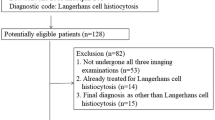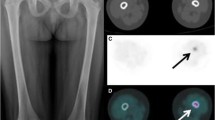Abstract
Background
In Langerhans cell histiocytosis (LCH) evaluation of the extent of disease is one of the major predictors of patient outcome. Historically this is undertaken using plain radiography and bone scintigraphy. Recently, whole-body (WB) MRI has been reported to be useful in detecting skeletal and extraskeletal metastases in both adults and children.
Objective
To evaluate the usefulness of WB MRI in patients with LCH in comparison with plain radiography and bone scintigraphy.
Materials and methods
In nine children (1–7 years of age; mean 3.3 years) who had a pathological diagnosis of LCH and had either plain radiography or bone scintigraphy for comparison, 43 WB MR examinations were performed. Skeletal and extraskeletal lesions of the disease on WB MRI were compared with those on plain radiography and bone scintigraphy.
Results
LCH showed unifocal single-system involvement in one patient, multifocal single-system involvement in three, and multifocal multisystem disease in five. WB MRI identified additional skeletal lesions in three (38%) of eight patients, compared with plain radiography, and in two (25%) of eight, compared with bone scintigraphy. WB MRI detected extraskeletal lesions of the disease in five (56%) of the nine patients exclusively, except for one patient whose lung lesions were also detected on plain radiography. In two patients, treatment was changed according to WB MRI findings.
Conclusion
WB MRI is a useful initial and follow-up diagnostic method to assess the extent of LCH because WB MRI not only identifies more skeletal lesions of the disease than do plain radiography and bone scintigraphy, but also detects extraskeletal lesions of the disease.








Similar content being viewed by others
References
Meyer JS, Harty MP, Mahboubi S, et al (1995) Langerhans cell histiocytosis: presentation and evolution of radiologic findings with clinical correlation. Radiographics 15:1135–1146
Azouz EM, Saigal G, Rodriguez MM, et al (2005) Langerhans cell histiocytosis: pathology, imaging and treatment of skeletal involvement. Pediatr Radiol 35:103–115
Schmidt S, Eich G, Hanquinet S, et al (2004) Extra-osseous involvement of Langerhans cell histiocytosis in children. Pediatr Radiol 34:313–321
Lauenstein TC, Freundenberg LS, Goehde SC, et al (2002) Whole-body MRI using a rolling table platform for the detection of bone metastases. Eur Radiol 12:2091–2099
Walker R, Kessar P, Blanhard R, et al (2000) Turbo STIR magnetic resonance imaging as a whole-body screening tool for metastases in patients with breast carcinoma: preliminary clinical experience. J Magn Reson Imaging 11:343–350
Lauenstein TC, Goehde SC, Herborn CU, et al (2002) Three-dimensional volumetric interpolated breath hold MR imaging for whole-body tumor staging in less than 15 minutes: a feasibility study. AJR 179:445–449
Engelhard K, Hollenbach HP, Wohlfart K, et al (2004) Comparison of whole-body MRI with automatic moving table technique and bone scintigraphy for screening for bone metastases in patients with breast cancer. Eur Radiol 14:99–105
Hargaden G, O’Connell M, Kavanagh E, et al (2003) Current concepts in whole-body imaging using turbo short tau inversion recovery MR imaging. AJR 180:247–252
Iizuka-Mikami M, Nagai K, Yoshida K, et al (2004) Detection of bone marrow and extramedullary involvement in patients with non-Hodgkin’s lymphoma by whole-body MRI: comparison with bone and 67Ga scintigraphies. Eur Radiol 14:1074–1081
Kellenberger CJ, Epelman M, Miller SF, et al (2004) Fast STIR whole-body MR imaging in children. Radiographics 24:1317–1330
Kellenberger CJ, Miller SF, Khan M, et al (2004) Initial experience with FSE STIR whole-body MR imaging for staging lymphoma in children. Eur Radiol 14:1829–1841
Daldrup-Link HE, Franzius C, Link TM, et al (2001) Whole-body MR imaging for detection of bone metastases in children and young adults: comparison with skeletal scintigraphy and FDG PET. AJR 177:229–236
Mazumdar A, Siegel MJ, Narra V, et al (2002) Whole-body fast inversion recovery MR imaging of small cell neoplasms in pediatric patients: a pilot study. AJR 179:1261–1266
Laffan EE, O’Connor R, Ryan SP, et al (2004) Whole-body magnetic resonance imaging: a useful additional sequence in paediatric imaging. Pediatr Radiol 34:472–480
Goo HW, Choi SH, Ghim T, et al (2005) WB MRI of paediatric malignant tumors: comparison with conventional oncologic imaging methods. Pediatr Radiol 35:766–773
Conway JJ (1996) Commentary. Pediatr Radiol 26:742–743
Brenner DJ, Elliston CD (2004) Estimated radiation risks potentially associated with full-body CT screening. Radiology 232:735–738
Binkovitz LA, Olshefski RS, Adler BH (2003) Coincidence FDG-PET in the evaluation of Langerhans cell histiocytosis: preliminary findings. Pediatr Radiol 33:598–602
Jubran RF, Marachelian A, Dorey F, et al (2005) Predictors of outcome in children with Langerhans cell histiocytosis. Pediatr Blood Cancer 45:37–42
Sullivan JL, Woda AB (1998) Lymphohistiocytic disorders. In: Nathan DG, Orkin SH (eds) Nathan and Oski’s hematology of infancy and childhood, 5th edn. Saunders, Philadelphia, pp 1371–1374
Lanzkowsky P (1999) Manual of pediatric hematology and oncology, 3rd edn. Academic Press, San Diego, pp 584–589
McClain KL (2005) Drug therapy for the treatment of Langerhans cell histiocytosis. Expert Opin Pharmacother 6:2435–2441
Schroeder T, Ruehm SG, Debatin JF, et al (2005) Detection of pulmonary nodules using a 2D HASTE MR sequence: comparison with MDCT. AJR 185:979–984
Yang DH, Goo HW (2006) Generalized lymphangiomatosis: radiologic findings in three pediatric patients. Korean J Radiol (in press)
Author information
Authors and Affiliations
Corresponding author
Rights and permissions
About this article
Cite this article
Goo, H.W., Yang, D.H., Ra, Y.S. et al. Whole-body MRI of Langerhans cell histiocytosis: comparison with radiography and bone scintigraphy. Pediatr Radiol 36, 1019–1031 (2006). https://doi.org/10.1007/s00247-006-0246-7
Received:
Revised:
Accepted:
Published:
Issue Date:
DOI: https://doi.org/10.1007/s00247-006-0246-7




